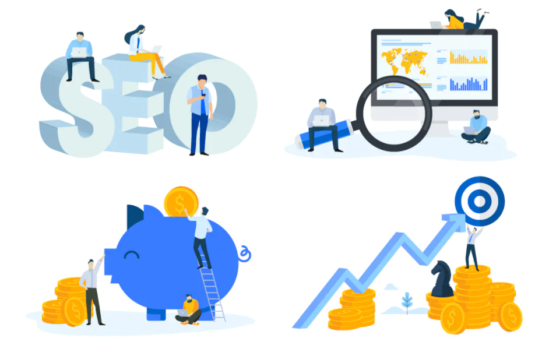Are you scrolling the internet to learn about how SEO works? Or how you can apply SEO to grow your business online presence? If yes then you have landed on the right article where we are going to highlight every small detail about SEO (search engine optimization).
Table of content:
- Background on Search engine optimization
- What is SEO?
- Why should websites care about SEO?
- How does SEO work?
- Basic Difference Between On-page SEO & Off-Page SEO
- How businesses get started with SEO?
- Understand what your potential customers are searching about
- Optimize your website and web pages for search results
- Ensuring that website is accessible by user and search engine
- Start building backlinks to showcase your authority
- Conclusion
Background on Search engine optimization
Undoubtedly SEO is considered one of the most important topics when it comes to driving organic traffic on the website or growing online presence. But still, are there people who are not aware of how SEO functions? Few people also feel that SEO is hard (due to a lot of competition) and not worth spending time on it.
If you feel the same then read this guide carefully as you are going to discover a lot of new things about SEO (search engine optimization). First, let me clarify that SEO is not complicated but ranking for highly competitive keywords can be difficult. So don’t get confused and stop your work thinking that SEO is difficult.
Today on google more than 3.5 billion searches are conducted by users with the goal to either purchase something or learn something or to find the answer to their question. So no matter what field and industry your business is operating there are high chances that your potential customers might be looking for your product/services in search results.
Optimizing your website depending on the search engine guidelines helps you to rank on the search engine result page. SEO is the practice and process of making your website eligible for those rankings. Now you might be wondering about how SEO works? Don’t we will help you to find the right answer.
Reading this guide will help you to explore more about what is SEO? How you can optimize your website for search engines and different aspects of SEO. So, without any further delay let’s start by answering one of the most basic questions:
If you are looking to know about the importance of EAT and YMYL then make sure to check our blog on What Are E-A-T, YMYL & Beneficial Purposes? Explained With Search Quality Evaluator Guidelines
What is SEO?

SEO also refers to Search engine optimization is the process and practice of optimizing the website and performing other outside activities like link building, profile building, and more with a goal to increase the quantity and quality of organic traffic by ranking on the top in search engine result page.
Breaking it down, even more, simpler search engine optimization is all about optimizing your article and web pages for search engines so that search engine crawlers can easily crawl your web page and rank for the dedicated keyword.
SEO is categorized into two types:
- On pages SEO
- Off pages SEO
Both types of SEO play an important role in making your website rank on the top in SERP. Using on-page SEO practices you can make your website friendly for users as well as search engines. On the other hand off-page, SEO helps you to showcase your website authenticity and authority which increases the chances of getting your website ranked on the top in SERP.
In the coming paragraphs, we are going to give in-depth ideas of different on and off-page SEO functioning but before that let’s determine why SEO is essential for your website.
Why should websites care about SEO?

If you wonder why you should care about SEO then here is the answer: In today’s competitive world there are two ways you can drive traffic to your website. Either by paying to search engines and asking them to rank your website on the top in the search engine result page “by running paid ads’ ‘. These types of traffic are called “paid traffic” where you schedule and publish ads. Running paid ads regularly can be costly and can go up to $10000/ month.
That is the reason why websites and businesses focus on SEO. Optimizing your website for search engines and performing various SEO activities helps you rank on the top in search engines and drive organic traffic without paying a single penny to search engines.
As mentioned earlier more than 3.8 billion searches are performed daily on google. From the number, you can easily recognize that your prospects might be searching for your product/services on the internet. SEO is the practice that helps websites to get visible in the search results.
Not only that but the traffic offered by google is very specific and high intent traffic means the users that are visiting your website are likely to convert if your website design and interface meet their expectations.
Search engines list the website in the search results depending on the keyword intent For example if you are selling dog food and targeting your website with the same then people that are looking to buy dog food may visit your website if it’s listed on the top in the search result page.
In short SEO (search engine optimization) is essential if you are looking to drive more organic traffic to your website. But in today’s competitive marketplace with lots of websites trying to rank on the top for mostly search keywords. Getting your website listed for the same can be difficult but it’s not impossible. With the right strategy and effort, you can rank yo9ur website and drive traffic from it.
How does SEO work?

By now you might have a clear idea about the basics of SEO. Next, lest understand how SEO works. Most of the people who are not aware of SEO think that search engines are websites where users put their query in the search box and in reply they get a list of websites or web pages as their answer or solution. Well, it’s true search engines like google, yahoo, bing, and more are created with a goal to help users.
But have you ever wondered how the list website appears when you type the keyword or some phrase in the search bar? Every search engine has a crawler dedicated to crawl every content on the internet and gather information so that if a user puts some query in the search box, the search engine is able to reply back with the right information.
If you think that Google is the one working behind every content then it’s wrong. Google is just gathering and displaying the content written and published by other websites. Websites that are producing those content ensures that it contains the right keyword so that when search engine bot crawls the website they are able to understand which keyword or phrase your web page should get listed in SERP.
Depending on your web page authority, user-friendliness, and more the ranking is assigned to each website. There might be hundreds and thousands of websites writing the same content so depending on some ranking factor google assigns the rank to each web page.
Basic Difference Between On-page SEO & Off-Page SEO

By now you might be familiar with what SEO (search engine optimization) is, why you need it and how it works. That means you already have the basic knowledge about SEO. Next, we are going to give you detailed information about how you can make use of SEO techniques to make your web pages visible on the search engine results page. But before that let’s understand the basics of the on-page and off SEO.
On-page SEO:
The activities you perform inside your website with a goal to make your web pages rank higher in the SERP are called on-page or on-site SEO. Today every search engine wants to offer the best results to their searchers. That is the reason why it’s important for websites to optimize their web pages, titles, descriptions, and more. So let’s take a look at some of the common on-page SEO activities:
- Optimizing web pages meta title and description
- Image optimization
- Keyword research
- URL structure
- Internal linking
- H1, H2, and H3 tags
- Schema Markup
- Installing an SSL certificate
- Optimizing page load time
If you are looking to know more about on-page and off-page SEO then make sure to check our blog on Inbound marketing Series: 10 Underrated On-Page and Off-Page SEO Activities Explained With Examples
Off-Page SEO:
From the term, you can recognize that off-page SEO refers to the activity performed outside of the website with the goal to get built authority by getting backlinks from high authority websites. Blogger, content marketer, and site editor focus on getting more organic traffic by getting backlinks and social sharing as it is less expensive and the customer retention rate is more. Some of the off-page SEO activities include Building links, profile building, bookmarking, content marketing, and more.
How can businesses get started with SEO?
Now that you have basic knowledge of what is on-page and off-page SEO and how you can make use of it to rank your website on the top in the search engine result page. But most of the SEO guides you will find on the internet can educate you about SEO but very few tell you how to get started with it. Next, we are going to highlights some important on how you can get started with SEO:
1. Understand what your potential customers are searching about:

Until you are aware of what your customers are searching for, how are you going to optimize your website for them? So the first and foremost thing you need to do is determine what your customers are searching for.
To do that you can start with understanding what type of phrase they can use to search for your product. For example, if you are selling shoes online then users might use trams like buying casual shoes, formal shoes, and more. Make a sheet and write all the terms that your potential customer can use to reach your product.
These terms may not give you the exact phrases or terms used by them but will surely help you to discover many things, mainly it will help you identify what your potential customers are searching for. SO let’s take a look at some important points on how you can identify what your potential customers are searching for:
i. Identify a website that is ranking for those terms:
Once you have the list of terms that you gathered after going through the thinking process. next, you can go to google and type those in the search box and look for results. Once you hit the search button you will come across a list of websites that have already done some reason and optimized their website title and description for those keywords.
Apart from that, you can also make use of various keyword explorer tools like ubersuggest, Ahrefs keyword explorer, and more to identify the list of keywords that might be used by the user. Once you have that, take them down with the keyword volume so that you are able to decide which one is frequently used by the user in the search engine.
The website in your niche must be getting traffic from various long-tail and related keywords. That means every user is not typing the word “buy shoe online” in the search box. They might be using some other long-tail keywords or related terms to search for the product.
Remember different people might be using different terms to search for the same product. By analyzing the title and description of different web pages in the search results you can start to get a good idea about the terms users might be using.
Above we listed some of the keyword explorers that can give you in-depth ideas about the top-performing keywords that you use to target your web pages. But we recommend that you continue your research as you will come across many related terms for your product and services.
ii. Dive in deeper to identify related terms (by taking the help of google)
By now you might have a list of phrases and terms which you can use to target your web pages but before you make your final decision we recommend diving in deeper to understand what users are searching about.
To optimize user experience, google search offers multiple suggestions related to the user queries. When users enter the first few words of their query in the search box a suggestion box appears containing all the related terms For example if the user is searching for terms like buys shoe then all the long term and related keywords start to appear in the search box.
The search engine does not generate these suggestions. Instead, they record the previous searches performed by other users, and depending on that the suggestions are offered to users. So to identify what users are searching for you can take a look at google autocomplete results.
Go to the Google search box and start typing the terms that relate to your niche but make sure you don’t hit the enter. A dropdown suggestion box will appear with some additional terms related to phrases you entered in the search box. You can also consider them while researching for keywords.
iii. Look for a more related term by expanding your search
From the above tips, you may a bunch of keywords in your sheet but to outperform other web pages that are already driving a bunch of traffic and conversion we recommend getting more close to the audience and learn about how and what they are talking about the niche you are working in, what type of problems they are facing and the terms used by them while communicating.
Now you might be wondering how are you going to find the audiences so that you can get a better understanding of them. To find your audience
- You can visit different forums that belong to your niche
- Read the question on Quora, visit Reddit blogs and check the comment,
- Join different Facebook and LinkedIn groups relating to your niche
These are the places people spend time and talk about their problems, share their opinions, and more. Using these platforms you can get a better understanding of what people are talking about and how you can make use of it in your SEO strategy and sometimes it also helps you to improve your business and website functioning.
Therefore keywords are nothing but the term generated by the user. SO the better you understand your potential audience the higher your chances of getting your website ranked on the top in SERP.
iv. Metrics to target when doing keyword research
Most of the websites and webmasters run behind two popular metrics search volume and keyword difficulty. Well, these two metrics are actually important as it helps you to get insight into the potential of each keyword like how hard it can be to rank for the keyword, total number of monthly searches and more.
These metrics are important as they help you to understand what is best for your website and web pages but sometimes volumes are high but don’t offer the desired traffic that is the reason why we also recommend you to check the traffic potential of each keyword. So that you are aware of the keywords that are good with search volume and capable of driving more organic traffic.
Using keyword tools you can get detailed ideas about the estimated monthly traffic for that particular keyword. Once you are aware of the keyword with good volume and traffic potential then you can also define your competitor. Remember that in your SEO and marketing strategy competitor analysis is going to play an important role so don’t forget to analyze what keyword your competitors are using to rank their web pages.
Earlier we could have told you about competitor analysis but competitor analysis makes websites and webmasters lazy. Once website owners are aware of the keywords they ignore all the steps that we mentioned in the above paragraphs. So before jumping into competitor analysis we recommend going through every step so that you are able to discover more about your customers.
2. Optimize your website and web pages for search results
Once you are aware of the keyword that you wish to rank for. Next comes the important part that is optimizing your web page and website for search engines. Google is rolling out core updates every month with a goal to optimize user experiences. So they expect the same from other websites as well.
When it comes to optimizing a website, you need to start with the UX (user experience). You need to ensure that the typography, design, and more should make it easy for users to access your web pages and consume the content. Adding too many popups, opt-in boxes, and spaces for ads can annoy site visitors, and when it comes to ranking these websites get less preference by Google.
From the optimization, you might have figured out that we are talking about ON page optimization. No matter whether you are creating the best design or targeting a less competitive keyword if your website is not optimized there are fewer to no chances of getting the website ranking.
So the question is how to optimize the website for search engines?
i. Create Simple and descriptive URLs
The URL of your website and web pages plays a crucial role as it helps search engines to understand the purpose of the page. That is the reason why every SEO expert recommends adding the keyword in the URL.
Before you get started with other off-page SEO activities we recommend ensuring that URL structure is right and contains the necessary keyword because changing it again in the future can damage the backlinks you generated from another website.
Make sure the URL structure is simple and short. Avoid adding the number to your URL, for example, a URL “abc.com/ SEO-guide” is always preferred over “abc.com/84576-5224587” by the search engine as well as the user. Creating a descriptive URL also helps you to add a dedicated keyword.
ii. Add keyword in your meta title and description
After optimizing the URL next you can jump on optimizing two important factors of the web page “the meta title and description”. The Meta title is nothing but the tile that the search engine will use to display your page in the search results. The same will be used by the user to understand the purpose of the web page.
That’s why it’s important for you to create a short, simple, and keyword-rich title that grabs both searches as well as user attention. Here are few
- Make sure your title doesn’t exceed the google limit (not more than 60 characters)
- The meta title contains the dedicated keyword for which you want the page to rank
- Craft a compelling title that encourages users to click on it
Most of the site owners commit a mistake by creating a title that exceeds the character limits. On the search result page, only 60 characters are viewed by the user so if your title exceeds the character limit then there are chances that your web page may fail to deliver its actual purpose.
Meta description also plays an important role in getting clicks from the user. Gone are those days when users used to open the content and check what’s in it. Now searchers are becoming smarter if your description does not address the pain point then the user may shift to some other website. So make sure within 155 characters your description is giving a summary of your website.
iii. Optimize your images
Images enhance the appearance of the website but when it comes to delivering the purpose of the image sometimes you need to help search engines to identify them. Before uploading the images we recommend you to optimize it by adding the alt text or alt tag. It helps search engines understand the purpose of the image.
Another thing you can consider while opting for the website image is the size of the image. Adding too many heavy images (big files) can slow your website speed which may affect your website ranking. So we recommend either use the image compressing plugin or compress the image before uploading it on your website.
iv. Include headers and subheader in your web pages
Whether you are using an HTML-coded website or a wordpress website it’s important to understand that when it comes to ranking search engines always give preference to a well-structured website. Adding headers (H1 to H6) to your web pages makes it easy for the user as well as a search engine to understand the importance of each section and mainly the structure of the page.
Header 1 is the title of your web pages or your content. So make sure when you upload the content don’t forget to add the keyword in the title and mark it as H1. The H2 or header 2 should be used under the H1 tag or after the title of your web pages. Make sure your h2 also contains the keyword as it can help search engines to get a clear understanding of what you are trying to deliver.
So this is how it works. As you go down in your content you need to mark the subheaders as H2, H3, H4, H5, and more. For example, if you are writing a blog on some topic the this how you can assign the header: First the title will be H1, next the subtitle will be marked as H2 if the H2 contain a sub-heading then it will be marked H3 and if the h3 contain other points that need to be elaborated then it should be marked as H4
v. Offer content that matches search intent
Identifying and understanding the search intent is crucial to ranking. If you wish to rank your web pages on the top and drive quality traffic to your website then it’s important to understand what users are searching for and why they are searching for it. Because Google also gives the results in the SERP based on the intent behind the query.
A user may either look to purchase something or learn about some topic and most of the time they use Google to search for a particular website. So if users are searching for something then there is some intent behind it and this traffic is called the quality traffic that is more likely to convert. But to make them land on your website you need to create content that matches the intent.
Once Google recognizes that your website is the answer to the user’s question then you are more likely to appear in the search results. That it’s recommended to create and offer content that matches search intent.
3. Ensuring that your website is accessible by both user as well as the search engine
When you start optimizing your website it’s important to follow the search engine guidelines but remember the optimization is for the user. Because at the end search is going re your web pages to searchers and they want to offer the best experience to users. So when you optimize your website make sure you do it keeping search engines as well as users both in consideration.
Google is continuously trying to make its crawler smart and intelligent so that it can pick the best web pages and offer the best result to users. That’s why you need to ensure that your website is both user as well as search engine friendly. So below we are going to highlight some tips that you can consider to optimize your web pages for better ranking:
i. Start by optimizing the website load time
No matter how effective and attractive your website is for users if the website takes more than 3 seconds to display its elements in the website then more than 40% of the users abandon the website and never return back.
Using various tools like Google PageSpeed Insight and GTMetrix and more you can identify your website loading time. These tools will give you detailed ideas about the speed of your website and how you can improve the speed of your website. Try to minify your codes because having too many unwanted elements can increase the load time. To perform better in the search engine keep a track of your website loading time.
ii. Create a mobile-friendly website
Today most of the searches happen from mobile devices and when we say most then it means more than 60% of the searches happen from mobile devices. An official statement by google also states that 50% of the traffic comes from mobile devices.
So from the numbers, you can easily determine how important it is for websites to optimize their web pages for mobile devices. Using tools like Google Mobile-Friendly Test you can check whether your website and web pages are mobile-friendly or not.
iii. Website Security (install SSL certificate)
Security has become one of the primary concerns and also considered an important factor when it comes to ranking. If your website is not secured then Google will never recommend your web pages to its searchers. That’s why it’s important for every website to install the SSL certificate, Mainly if you are running an ecommerce website where users have to give their payment details then it’s a must to have an SSL certificate installed on your website.
After you install the SSL certificate you can find a lock symbol that indicates your website is secured. Not only that but you will also find “s” at the end of HTTP that indicates HTTPS means your website is secured.
iv. Create a structured XML sitemap
An XML sitemap is the crucial part of a website that helps search engines crawl your website more smartly. It’s not that search engine crawlers can’t crawl your website without a sitemap but having a sitemap helps crawlers to understand how your web pages are connected to each other in a structured way.
Generating an XML sitemap is not difficult, if you are using wordpress then you can make use of plugins like Yoast SEO to generate the sitemap. Or you can also make use of online sitemap generation tools available on the internet. Once you have the list of sitemaps then you can go to your google search console and upload the file.
If you think sitemap affects the ranking then the reality is it is a search engine to index your web pages fastly and smartly. These types of practices help you to rank better in search engine result pages.
v. Internal Linking
When it comes to SEO internal linking plays an important role and helps search engines to index your other pages. Whether you are aware or not but search engines crawl every link and the content inside the link in a web page. Internal linking allows you to link other pages within your website and is considered the best way to increase the indexing speed.
Try to link as many pages as possible so that when a search engine crawls any of your web pages they go to other pages and index them. If you are writing a blog and have a relevant blog present on your website then you can create an anchor of that page in the blog you are going to publish. Interlinking is alone a new topic that we will highlight in our upcoming blog. For now, you just try to interlink pages within your website.
4. Start building backlinks to showcase your authority
All the above SEO tips focus on making your website use as well as search engine friendly. Using those tips you can optimize your website for search engines but when it comes to ranking you need to prove that you are eligible to get top rank. When it comes to SEO success link building plays a crucial role and for that, you need to have content as well as off-page SEO strategy ready.
Link building is a time taking process where you need to dedicate time to prepare quality content and get a link back from another high authority website so that you give a reason to search engines on why they should rank your website on the top in SERP. Agin link building is a huge topic and there are a lot of things that you can do to get a link back from another website. Below we are going to highlight some of the important link building techniques:
i. Get your blog pages to link exchanges with low-quality content (backlink)
If you have published high-quality content for example on social media and you feel that the constant contains all the necessary information that can help readers. Then you can plan to swipe your content links with low-quality content. There are many web pages that are offering backlinks to inferior content.
So you can use the opportunity to get your blog link in place of the inferior content. All you have to do is use tools like Ahrefs and SEMrush. Go to the content explorer and find the blog on the same topic and look at their referring domain. If you feel the quality of the content is not up to the mark reach out to the website owner and tell them what they should swipe your web pages link with the existing one. If the site owner is convinced then there are chances that you can get a backlink from them.
ii. Broken link building
Another popular way to get the backlink is through broken links. Today on the web there are a lot of websites that contain dead or broken links on their pages. All you have to do is find them and ask them to replace it with your link. Doing it manually can be a time taking process where you have to visit each site manually and can look for broken links by clicking on each one of them.
Using tools like Ahref and SEMrush you can check the broken link report and look for web pages that contain broken links. Once you identify them you can reach out to the website owner and tell them that their web page contains a broken link and it can get replaced by your web page link.
iii. Guest blogging
From the name you could have recognized that guest blogging is all about wiring blogs for other websites within your industry. Most webmasters think that guest blogging is not useful but in reality, it can help you to get more quality links from high authority websites. Yes, guest blogging is a time taking process and most of the website does not allow bloggers to place their website link. But still, if you manage to get 2 or 3 backlinks from a high authority domain then that will be equal to hundreds of low-quality links.
Link building is a huge topic that requires separate articles. In our upcoming article, we will be giving in-depth ideas about different link building techniques.
Conclusion
By now you might have a good idea about what is SEO and how you can get started with it. Remember in the beginning you might face difficulties and for the first one or two months, you might not get the results you desire. But as you start spending more and more time on various SEO techniques you will start seeing the results. So it’s all about how much time you are dedicating to website and SEO.
On the other hand, if you don’t have much time and wish to focus more on growing your business then you can always plan to hire an experienced SEO agency that can help you to grow in the competitive marketplace.
